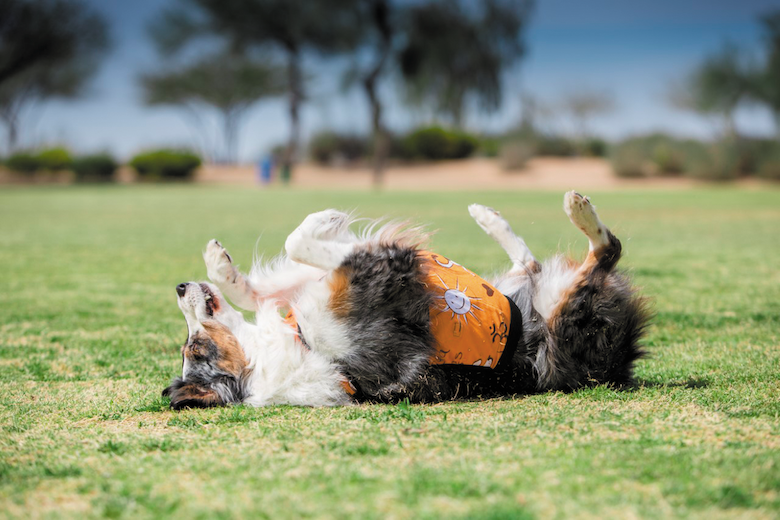The post Get Your Dog Ready for Spring! How to Prep for Seasonal Parasites, Diseases and Allergies by Arden Moore appeared first on Dogster. Copying over entire articles infringes on copyright laws. You may not be aware of it, but all of these articles were assigned, contracted and paid for, so they aren’t considered public domain. However, we appreciate that you like the article and would love it if you continued sharing just the first paragraph of an article, then linking out to the rest of the piece on Dogster.com.
Springtime ushers in such pleasantries as the welcome sight of butterflies doing ballet-like moves in the sky, the sweet fragrance of flowers blooming and the sounds of happy birds chirping. But there is a dangerous, dark side to spring, especially for your dog.
Unchecked and unprotected, your dog can be bombarded by fleas and ticks as well as develop heartworm, leptospirosis, Lyme disease and, yep, hot spots.
Fortunately, help is here. For starters, Dogster sought answers from arguably the world’s leading authority on fleas and ticks — Michael Dryden, DVM, PhD, aka Dr. Flea. He earned what is believed to be the world’s first doctorate degree in the study of fleas from Purdue University nearly 30 years ago and has been the go-to expert testing the generations of flea and tick preventives on the market ever since.
“Many medications today that deal with fleas, ticks and heartworm disease work well, but the best one is the one that the dog owner uses consistently,” says Dr. Dryden, distinguished professor of veterinary parasitology at Kansas State University in Manhattan, Kansas. “We need to get away from a seasonal approach to controlling parasites and get into the habit of using preventives year-round on dogs no matter where you live.”
Fending off fleas and ticks
Fleas are hardy survivalists. Consider these flea facts: Flea eggs can drop out of the hair of a
trespassing raccoon or opossum in your backyard and survive for eight weeks and then land on your dog. A female flea that lands on your dog can lay up to 50 eggs a day.
Fleas can put your dog at risk of developing anemia, flea allergy dermatitis, tapeworm and other conditions.
“The good news is in the war against fleas and ticks, we are in good stead,” Dr. Dryden says. “The new generation of flea and tick products are remarkable at the speed of killing fleas not only when first given, but throughout the duration of the label. The key is following the label instructions and using consistently.”
Just some of these products include chewables NexGard and Bravecto, topicals K9 Advantage II and Frontline Plus as well as Capstar pills and Seresto collars that fend off fleas and ticks for up to eight months when worn properly — not too loose around the dog’s neck.
What about the effectiveness of non-commercial flea/tick products, such as the use of diatomaceous earth, borax or beneficial nematodes (worms) or giving yeast and garlic supplements to dogs to repel fleas and ticks?
“Back in the late 1990s, we went through a battery of tests to try to validate these, but there have been no scientific studies to date that show any significant benefits of these holistic options on fleas and ticks,” Dr. Dryden says.
Photo: andriano_cz | Getty Images
Dogs are at risk for a host of diseases transmitted by ticks, with Lyme disease ranking among the most common type. A tick will attach onto a dog, bite it and release bacteria into the bloodstream, resulting in fever, lameness, joint swelling and enlarged lymph nodes. Untreated, Lyme disease can shut down the kidneys and cause death.
Dr. Dryden urges pet parents to get into the habit of doing a thorough head-to-tail inspection of their dogs after a walk in the woods or heavily treed area. Ticks like to hide in a dog’s lips, ears and between the toes. And, don’t stop checking just because it’s cold outside. Ticks can be active all year long, especially if the temperature is above freezing; deer ticks actually become active after the first frost.
“Ticks are harder to kill than fleas, and a dog can encounter 50 or more ticks from running in the woods,” Dr. Dryden says. “It may surprise people, but ticks are not able to leap, jump or fly. They wait on shrubs, grass and bushes for an animal or person to go by and grab on. They attach within 10 minutes but may take hours to bite and transmit pathogens like Lyme disease.”
He continues, “Using fingernail polish or Vaseline to remove a tick do not work. The best way to remove a tick is to grab it with tweezers close to the skin and pull straight out. Do not twist it. And always wash your hands thoroughly afterward.”
Heartworm is a sneaky disease
The war on heartworm disease continues to be challenging. Untreated, heartworms growing in a dog can cause heart failure, lung damage and death. Cases of dogs infected with heartworm have been reported in every state, according to the American Heartworm Association. People can see a flea or a tick on their dogs and react immediately, but heartworm is more of a hidden disease with clinical signs that develop slowly, Dr. Dryden says. “We need to find a more technology-driven way to remind people to give their dogs heartworm preventives consistently for their entire lives.”
ProHeart 12 is a yearly injectable that prevents heartworm disease. There are also monthly chewable preventives, such as Heartgard Plus and Interceptor Plus as well as topical spot-on medications, such as Advantage Multi Topical Solution and Revolution Topical Solution. All are available as prescriptions from veterinarians.
Dealing with Leptospirosis
A sneaky, dangerous bacteria lurking in your backyard is Leptospira. This hardy bacteria is spread by wildlife exposed to contaminated urine and other sources. It burrows into the skin or is inhaled through the nose and spreads through the bloodstream to damage the kidneys, liver, blood vessels and lungs.
This bacterial infection (leptospirosis) is also zoonotic, meaning your infected dog can infect you, too, if you do not practice good hygiene habits after cleaning up any urine messes in the house made by your dog.
“Even if you use paper towels to clean up the mess, still wash your hands with anti-bacterial soap,” says Mike LoSasso, DVM, emergency medicine veterinarian and chief of staff at Frisco Emergency Pet Care in Frisco, Texas. “Leptospirosis is a very serious disease, especially in people who are immune-compromised. Why take the risk?”

Photo: Tuff Photo by Victoria Rak; tuffphoto.com
To protect your dog, make sure he receives the leptospirosis vaccine each year.
“This is not a ‘core’ or mandatory vaccine, but I think at this point, it should be,” Dr. LoSasso says.
Stopping the scratch and itch
Some dogs develop environmental allergies that can worsen in the spring and trigger incessant scratching and licking that lead to conditions such as wet scabs on the skin known as hot spots. Flea bites, matted hair and allergic reactions to grasses, molds or pollen can cause hot spots.
Check with your veterinarian for the best treatment plan for your dog. Topical and oral antibiotics or hydrocortisone sprays or creams may be prescribed. Natural options include applying calendula cream or lotion or black tea on the site.

Photo: ©andriano_cz | Getty Image
Keep your dog from developing a dry, itchy coat by using pet shampoos with safe, mild herbs, and steer away from ones containing harsh chemicals on the ingredient label.
Still not sure how to handle these spring spoilers? Just talk to your veterinarian or seek out a holistic veterinarian if you prefer a more natural approach to guide you. Be prepared, and don’t let spring spring one on you and your dog. Work with your veterinarian to keep these pests, diseases and hot spots as a short spring shower in your otherwise sunny spring days.
Top photograph: Phido Photo
The post Get Your Dog Ready for Spring! How to Prep for Seasonal Parasites, Diseases and Allergies by Arden Moore appeared first on Dogster. Copying over entire articles infringes on copyright laws. You may not be aware of it, but all of these articles were assigned, contracted and paid for, so they aren’t considered public domain. However, we appreciate that you like the article and would love it if you continued sharing just the first paragraph of an article, then linking out to the rest of the piece on Dogster.com.


























